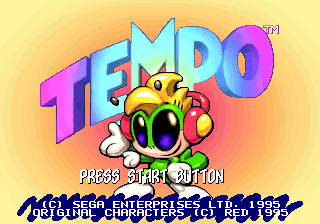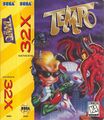Difference between revisions of "Tempo"
From Sega Retro
| Line 42: | Line 42: | ||
==Production Credits== | ==Production Credits== | ||
| + | {{multicol| | ||
'''Designer''': Keisuke Abe<br/> | '''Designer''': Keisuke Abe<br/> | ||
'''Character Animation Design''': Keita Komiyama<br/> | '''Character Animation Design''': Keita Komiyama<br/> | ||
| Line 68: | Line 69: | ||
'''Choreography (Dance Assistant)''': Yukiko Tsukamoto<br/> | '''Choreography (Dance Assistant)''': Yukiko Tsukamoto<br/> | ||
'''Supervisors''': Takashi Shoji, Takeshi Niimura, Ryoichi Hasegawa | '''Supervisors''': Takashi Shoji, Takeshi Niimura, Ryoichi Hasegawa | ||
| + | }} | ||
==Manuals== | ==Manuals== | ||
Revision as of 15:21, 13 January 2011
| Tempo |
|---|
| System(s): Sega 32X |
| Publisher: Sega |
| Developer: Red Entertainment Corporation |
| Genre: Action |
Tempo is a 1995 action platforming game developed for the Sega 32X by Red Entertainment Corporation. It was the first game in the Tempo series, and was followed by Tempo Jr. and Super Tempo.
In the game, you control a grasshopper named Tempo, who uses the power of music to rid the world of Rythmia from the minions of the music-hating King Dirge Sound on the television show The Major Minor Show. You defeat enemies by either jumping on them, falling on them, or kicking on them, and you can stun them by shooting music notes at them. When in midair, you can glide slowly downward, destroying any enemy that touches your feet. If you find a special DANCE panel, you can summon your butterfly friend Tina to assist in killing enemies and opening up secret paths.
Gameplay
The game plays like a straight platformer. ![]() causes Tempo to kick,
causes Tempo to kick, ![]() causes Tempo to jump, and
causes Tempo to jump, and ![]() causes Tempo to shoot musical notes from his hands. While in midair, holding
causes Tempo to shoot musical notes from his hands. While in midair, holding ![]() will cause Tempo to slowly float downward using his wings. Enemies are mainly killed by hitting them with your feet; kicking an enemy gives you +100 points each time, while jumping on them gives you +10. Shooting music notes will stun enemies (but won't affect the score you get when you destroy them). Two powerups available in the level will cause Tempo to shoot two notes at a time or eight notes in a circle each time; the powerups will fall from Tempo to nearby ground whenever he is hit.
will cause Tempo to slowly float downward using his wings. Enemies are mainly killed by hitting them with your feet; kicking an enemy gives you +100 points each time, while jumping on them gives you +10. Shooting music notes will stun enemies (but won't affect the score you get when you destroy them). Two powerups available in the level will cause Tempo to shoot two notes at a time or eight notes in a circle each time; the powerups will fall from Tempo to nearby ground whenever he is hit.
Finding a panel that says "DANCE" on it will cause Tina to appear. Tina will automatically kill certain enemies after a second of them being on screen. If you find a panel that says "TINA" while Tina is following you, Tina will destroy a nearby obstacle, opening up a secret path. The "DANCE" panel will also kill every enemy on screen at the time.
Health is measured by a health bar at the top left corner of the screen. You lose a certain amount of health with each hit, depending on the enemy or obstacle you hit. Once your health reaches a dangerously low point, Tina will flee. You can regain health by collection music notes scattered around the level. Green, red, and orange notes will refill a certain amount of health; the amount decreases with each respective color. A large yellow music note will refill your health once. Some platforms, such as the electric drums in Hi Fi Performace, will give you music notes of decreasing heath value each time they are jumped on.
In each level there is a set of diamonds blocking an alternate path that will electrocute you when touched. A nearby flower encased in ice will cause the diamonds to turn into music notes when touched.
In each level there is a series of trophy-like platforms similar to the one shown when Tempo starts the level; standing on these will warp you to a different part of the level. These platforms usually come in pairs, so standing on one will always take you to the other.
Levels
The game's stages are divided into three different levels; hitting up and down on the stage select screen allow you to choose the level to choose the stage to play from, though you must beat all the stages on one level to be able to go to the next.
- Ground Level
- Indigestion Performance: Fight your way through the mouth and into the belly of a large monster to fight a boxing glove in a boxing ring.
- Hi Fi Performance: A digital maze of conveyor belts, electric drum pads, electroshock televisions, and dancing bug monsters in the background frame this gimmick-filled area, ending with a fight with a pair of headphones.
- Downtown Performance: An urban city filled with basketball-playing enemies, skyscrapers that rise and fall, and lots of city-related gimmicks leading to a fight with a giant shoe.
- Second Level
- Circus Performance
- Jungle Performance
- Top Level
Production Credits
Designer: Keisuke Abe
Character Animation Design: Keita Komiyama
Producers: Hiroshi Aso, Yukihiko Hojo (RED), Mike Larsen
Assistant Game Designer: Ryoma Kaneko (RED)
Assistant Producer: Bill Person
Lead Programmer: Tsukasa Aoki
Player Programmer: Yuzo Iwai
Enemy Programmer: Naohiro Hirao
32X Programmer: Masanaga Uekusa
Miscellaneous Utilities: Tomonobu Takahashi
Object Graphics: Hiroyuki Hirama
32X Graphics: Masahiro Kumono
Background Graphics: Yuta Ihara, Mototaka Nakatsu
Graphics Assistant: Akira Soejima, Yasuhumi Yamaguchi
Assistant Map Designer: Hito Ii (RED), G. Chatani (RED)
Product Manager: Ami Matsumura-Blaire
Lead Testers: Norihito Sekine, Jeff B. Junio
Assistant Lead Testers: Lorne Asuncion, Don Carmichael, Mikael Herauf
Music: Chamy
Composer: Hiroyuki Hamada
Sound Effects: Masaru Setsumaru
Sound Programmers: Atsumu Miyazawa, Akio Setsumasa
Vocals: Dawn Marie Moore, Jerick De Perio, Bob Timbello (RED)
Choreography: Hiro Kurosu
Choreography (Dance Assistant): Yukiko Tsukamoto
Supervisors: Takashi Shoji, Takeshi Niimura, Ryoichi Hasegawa





